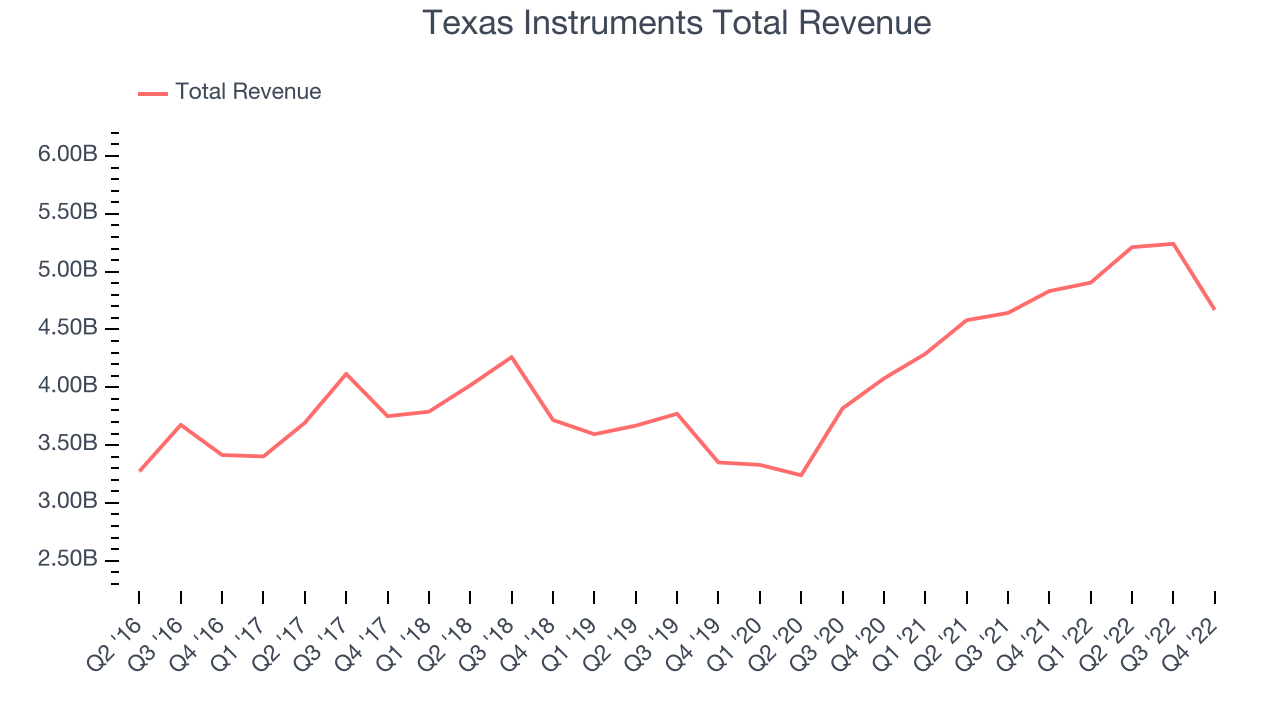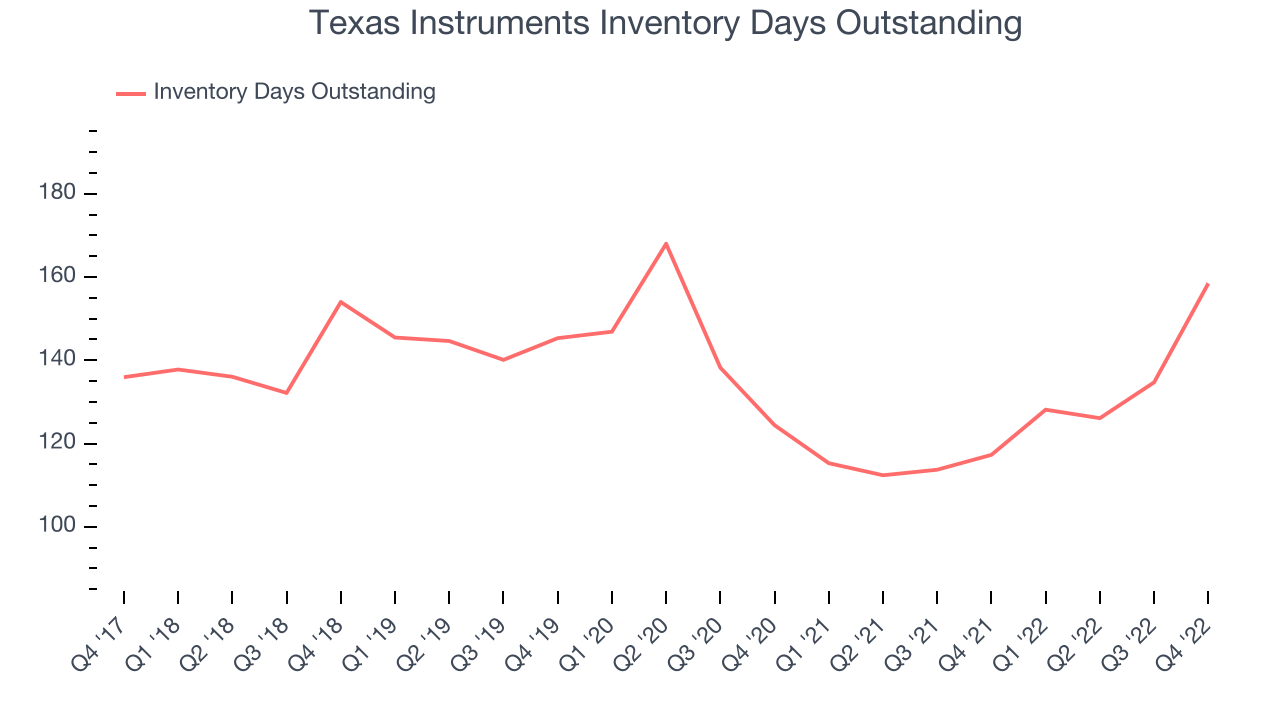Analog chip manufacturer Texas Instruments (NASDAQ:TXN) reported results in line with analyst expectations in Q4 FY2022 quarter, with revenue down 3.35% year on year to $4.67 billion. However, guidance for the next quarter was less impressive, coming in at $4.35 billion at the midpoint, being 1.66% below analyst estimates. Texas Instruments made a GAAP profit of $1.96 billion, down on its profit of $2.13 billion, in the same quarter last year.
Is now the time to buy Texas Instruments? Access our full analysis of the earnings results here, it's free.
Texas Instruments (TXN) Q4 FY2022 Highlights:
- Revenue: $4.67 billion vs analyst estimates of $4.62 billion (0.92% beat)
- EPS: $2.13 vs analyst estimates of $1.98 (7.69% beat)
- Revenue guidance for Q1 2023 is $4.35 billion at the midpoint, below analyst estimates of $4.42 billion
- Free cash flow of $1.07 billion, down 45.5% from previous quarter
- Inventory Days Outstanding: 158, up from 135 previous quarter
- Gross Margin (GAAP): 66.1%, down from 69.3% same quarter last year
Headquartered in Dallas, Texas since the 1950s, Texas Instruments (NASDAQ: TXN) is the world’s largest producer of analog semiconductors.
Demand for analog chips is generally linked to the overall level of economic growth, as analog chips serve as the building blocks of most electronic goods and equipment. Unlike digital chip designers, analog chip makers tend to produce the majority of their own chips, as analog chip production does not require expensive leading edge nodes. Less dependent on major secular growth drivers, analog product cycles are much longer, often 5-7 years.
Sales Growth
Texas Instruments's revenue growth over the last three years has been unremarkable, averaging 12.6% annually. Last year the quarterly revenue declined from $4.83 billion to $4.67 billion. Semiconductors are a cyclical industry and long-term investors should be prepared for periods of high growth, followed by periods of revenue contractions (which can sometimes offer opportune times to buy).

Despite Texas Instruments revenues beating analyst estimates, this was still a slow quarter with a 3.35% revenue decline. Texas Instruments's revenue is continuing to decline, signal that the current downcycle is deepening.
Revenue growth went from positive to negative this quarter, and Texas Instruments expects it to stay negative next quarter with an estimated decline of 11.3% YoY and analysts think the declines will continue, with next twelve months estimated at 8.66% declines.
In volatile times like these we look for robust businesses with strong pricing power. Unknown to most investors, this company is one of the highest-quality software companies in the world, and their software products have been the default standard in critical industries for decades. The result is an impressive business that is up an incredible 18,152% since the IPO. You can find it on our platform for free.
Product Demand & Outstanding Inventory
Days Inventory Outstanding (DIO) are an important metric for chipmakers, as it reflects the capital intensity of the business and the cyclical nature of semiconductor supply and demand. In a tight supply environment, inventories tend to be stable, allowing chipmakers to exert pricing power. Steadily increasing DIO can be a warning sign that demand is weak, and if inventories continue to rise the company may have to downsize production.

This quarter, Texas Instruments’s inventory days came in at 158, 23 days above the five year average, suggesting that that inventory has grown to higher levels than what we used to see in the past.
Key Takeaways from Texas Instruments's Q4 Results
Sporting a market capitalization of $161 billion, more than $9.06 billion in cash and with positive free cash flow over the last twelve months, we're confident that Texas Instruments has the resources it needs to pursue a high growth business strategy.
Texas Instruments topped analysts’ revenue expectations this quarter, even if just narrowly. That feature of these results really stood out as a positive. On the other hand, it was less good to see that the revenue growth was quite weak and the revenue guidance for the next quarter missed analysts' expectations. Overall, this quarter's results could have been better. The company is down 1.77% on the results and currently trades at $173.96 per share.
Texas Instruments may have had a tough quarter, but does that actually create an opportunity to invest right now? It is important that you take into account its valuation and business qualities, as well as what happened in the latest quarter. We look at that in our actionable report which you can read here, it's free.
One way to find opportunities in the market is to watch for generational shifts in the economy. Almost every company is slowly finding itself becoming a technology company and facing cybersecurity risks and as a result, the demand for cloud-native cybersecurity is skyrocketing. This company is leading a massive technological shift in the industry and with revenue growth of 70% year on year and best-in-class SaaS metrics it should definitely be on your radar.
The author has no position in any of the stocks mentioned.
